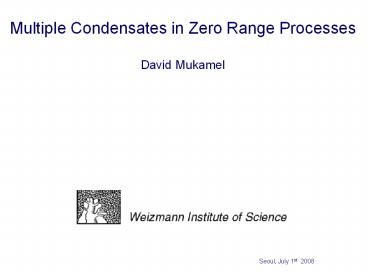Multiple%20Condensates%20in%20Zero%20Range%20Processes - PowerPoint PPT Presentation
Title:
Multiple%20Condensates%20in%20Zero%20Range%20Processes
Description:
A ZRP model with non-conserving processes. Connection to network dynamics. hopping rate: ... Non conserving ZRP. A. Angel, M.R. Evans, E. Levine, D. Mukamel, ... – PowerPoint PPT presentation
Number of Views:56
Avg rating:3.0/5.0
Title: Multiple%20Condensates%20in%20Zero%20Range%20Processes
1
Multiple Condensates in Zero Range
Processes David Mukamel
Seoul, July 1st 2008
2
Zero Range Process A model
which has been used to probe condensation
phenomena In non-equilibrium driven systems.
3
condensation
Condensed state
Macroscopically homogeneous
Under what conditions does one expect
condensation do take place?
4
Minimal model Asymmetric Simple Exclusion
Process (ASEP)
dynamics
Steady State q1 corresponds to an Ising model
at T All microscopic states are equally
probable. Density is macroscopically
homogeneous. No liquid-gas transition (for any
density and q).
5
Extensions of the model more species (e.g. ABC
model) transition rate (q) depends on local
configuration (e.g. KLS model Katz, Lebowitz,
Spohn)
dynamics
Ordering and condensation in such models (?)
6
Criterion for condensation
domains exchange particles via their current
quantitative criterion?
7
Phase separation takes place in one of two cases
Case A
as
e.g.
and
Case B
8
Zero Range Processes
Particles in boxes with the following dynamics
9
Steady state distribution of ZRP processes
product measure
where z is a fugacity
For example if u(n)u (independent of n)
with
(determines )
10
An interesting choice of u(n) provides a
condensation transition at high densities.
11
The correlation length is determined by
-average number of particles in a box
12
For bgt2 there is a maximal possible density,
and hence a transition of the Bose Einstein
Condensation type.
For densities larger than c a condensate is
formed which contains a macroscopically large
number of particles.
13
Phase diagram for bgt2
0
p(n)
n
14
fluid
condensate
L-1000, N3000, b3
15
Use ZRP to probe possible types of
ordering. Multiple condensates? Can the
critical phase exist over a whole region rather
than at a point in parameter space?
16
Non-monotonic hopping rate multiple
condensates Y. Schwatrzkopf, M. R. Evans, D.
Mukamel. J. Phys. A, 41, 205001 (2008)
17
Typical occupation configuration obtained from
simulation (b3)
18
L1000, N2000, b3
19
(No Transcript)
20
Analysis of the occupation distribution
the fugacity z (L) is determined by the density
21
(No Transcript)
22
Up to logarithmic corrections the peak
parameters scale with the system size as
(condensate weight)
The peak is broad
23
Number of particles in a condensate
Number of condensates
The condensed phase is composed of a large number
(sub-extensive) of meso-condensates each contains
a sub-extensive number of particles such that the
total occupation of all meso-condensates
is extensive.
24
Another choice of u(n) a sharp
(exponential) cutoff at large densities
Here we expect condensates to contain up to aL
particles (extensive occupation), and hence
a finite number of condensates.
25
L1000, N 2300, a1, b4 critical density 0.5
26
Results of scaling analysis
number of condensates is Lw O(1)
27
Dynamics
temporal evolution of the occupation of a single
site
28
Arrhenius law approach
creation time
evaporation time
29
b4, k5, density3
30
Can one have a critical phase for a whole
range of densities (like self organized
criticality)?
A ZRP model with non-conserving
processes Connection to network dynamics
31
Non conserving ZRP
A. Angel, M.R. Evans, E. Levine, D. Mukamel, PRE
72, 046132 (2005) JSTAT P08017 (2007)
hopping rate creation rate annihilation
rate
32
Evolution equation (fully connected)
hopping current
33
Sum rules
normalization
hopping current
steady state density
34
Steady state distribution
Like a conserving ZRP with an effective hopping
rate
and
35
n
36
Steady state distribution
Is determined by the sum rule
37
(s,k) phase diagram
large s - small creation rate (1/Ls) - low
density small s large creation rate high
density intermediate s ?
38
conserving model
non-conserving s1.96 k3
b2.6, L10,000
39
Phase diagram
critical A
low density
critical B
weak high density
strong high density
40
(No Transcript)
41
Low density phase
The density vanishes in the thermodynamic
limit. The lattice is basically empty.
42
Critical phase A
bk/(k1)ltsltk
critical phase with a cutoff at Ly which
diverges in the thermodynamic limit
43
Critical phase B 2k/(k1)ltsltbk/(k1)
Weak peak
44
Most of the sites form a fluid with typically
low occupation. In addition a sub-extensive
number of sites Lw are highly occupied with
nn (meso-condensates)
no. of condensates condensate occupation
45
Weak high density k/(k1)ltslt2k/(k1)
Weak peak
46
Strong high density phase sltk/(k1)
no fluid, all site are highly occupied by n
particles
47
L5000 b2.6 k3
S2, 1.7, 1.2, 0.4
fully connected
1d lattice
48
Phase diagram
critical A
low density
critical B
weak high density
strong high density
49
Network dynamics
correspondence between networks and ZRP
node --- site link to a node --- particle
50
Rewiring dynamics
Networks with multiple and self links (tadpoles).
51
rewiring creation evaporation processes
c
i
a(ni)
u(ni)
j
one obtains the same results as for
the non-conserving ZRP
52
Here is the evaporation current
resulting from other nodes
53
Hence
54
b2.6 k3 s2 L1000, 2000, 4000
55
summary
The Zero-Range-Process may be used to probe
ordering phenomena in driven systems. Multiple
meso-condensates may result in certain
cases Generic critical phase (like self
organized criticality) Network dynamics may
exhibit similar phenomena
56
ABC Model
Random sequential update































